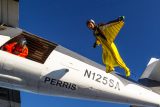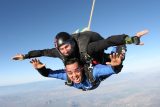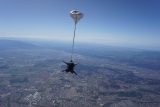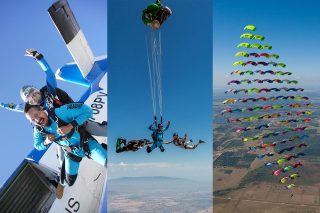
Stay Connected
Get personalized newsletters tailored to your interests! Choose from tandem skydiving, indoor skydiving, fun jumper events, or happenings at the Bombshelter Restaurant and Bar.
Posted by: Skydive Perris
5 years ago
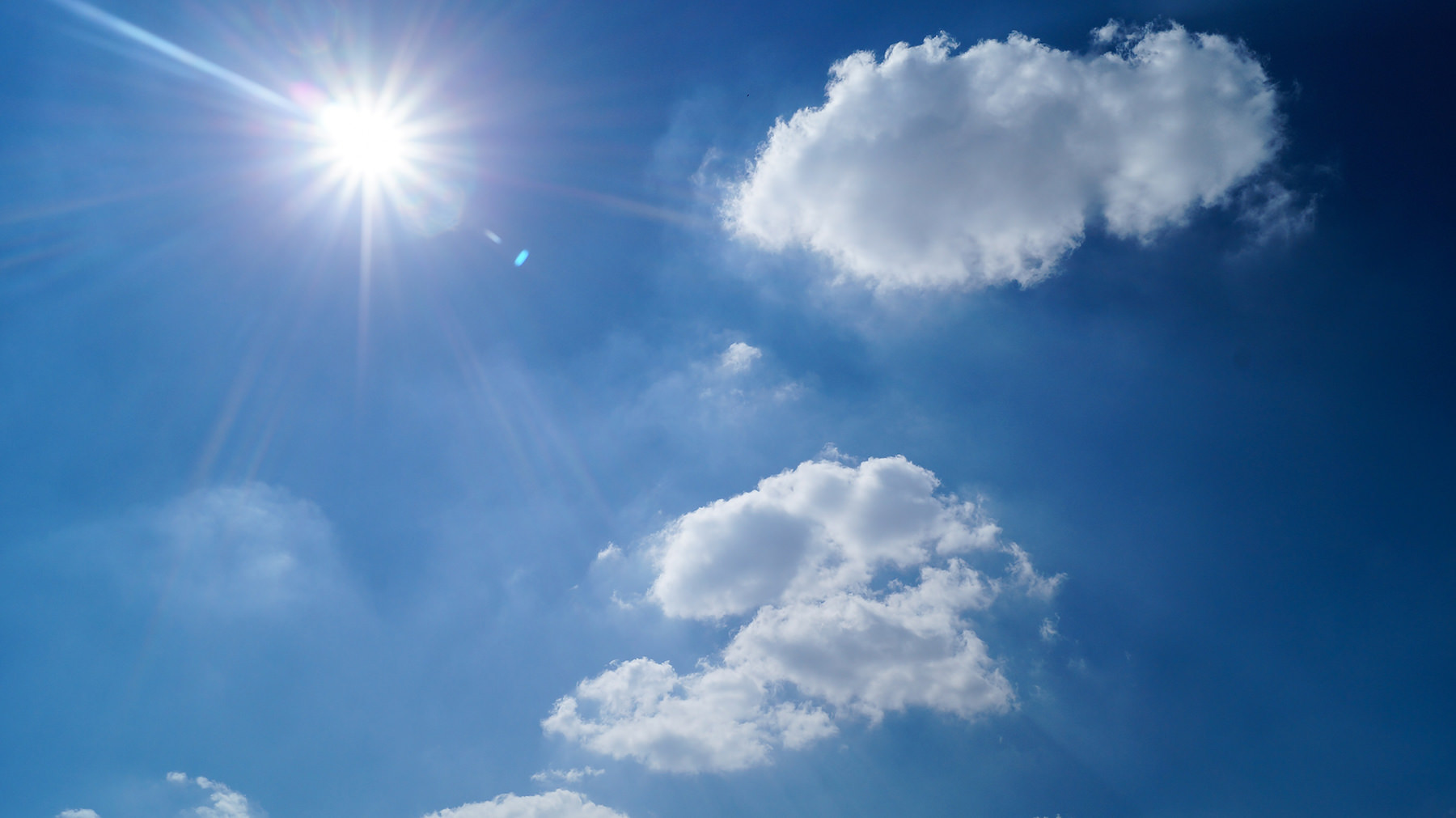
Here’s the deal, fair reader: If you’re playing in the sky, you’re playing in the weather. Yep! That means that the weather totally affects every “beat” of the skydiving experience, from the sun shining on your smiling face during freefall to the tinkerbell delicacy of your triumphant landing.
Parachute weather is pernickety, and that’s fine by us. The thing to know is that the very nicest skydiving weather conditions are also the best conditions to visit the beach: the weather is warm, the sky is clear and blue, and there’s a gentle breeze stirring the air. It’s true that deviations from that ideal are common and not always unpleasant (some clouds are fun!), but go far afield from those ideal skydiving weather conditions and things get less favorable for a jump. Here come insights and advice that we have on weather conditions for a safe and happy skydiving experience.
If the ground isn’t visible from the plane, we don’t jump. Sure, GPS is very likely to get us close to the mark, but all safety-minded skydivers (that’s your Perris Tandem Instructor!) know that it’s a terrible call to rely on them completely. The best tool to evaluate whether you’re getting out in the right place is your very own eyesight. Landing off the dropzone could put a baffled jumper in a tree, a lake, or a full parking lot.
Does it look like there aren’t too many clouds up there? Maybe think again. Even if the cloud seems broken in places, those “holes” are almost certainly moving around. Unless the Safety and Training Officer keeping an eye on things from the ground determines that there will certainly be a big space directly over the dropzone by the time the plane reaches exit altitude, all jumpers need to wait, from the newest first-time skydiving student to the most seasoned sport jumper.
Rain falls from clouds and, as we said before, clouds between the plane and the ground aren’t great for anybody. But even if the source clouds are higher than exit altitude, we tend to wait for the rain to pass.
Why? Well: we admit that the gentle patter of light rain down on your smiling face sounds pretty romantic, but make no mistake. When you’re skydiving, the sharp ends of each those raindrops are pointing up at you as you smack against them at 120mph. Ow. Seriously. It’s just not worth the misery.
Also: If we were to jump in the rain, the weight of the water in the fabric of our parachutes would negatively affect the way our parachutes fly.
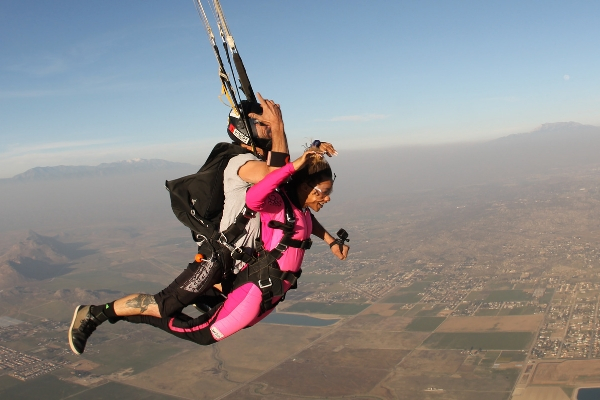
High winds significantly affect how our parachutes fly, pushing them off course. Sometimes, they even push them backward. Because of this, we enforce wind speed limits for different solo skydiving licensing levels. If you have a higher-level license, you’re given more latitude to decide what wind speeds you will and will not tolerate. Tandems have more latitude than A-license skydivers because of the high-level professional pilot and the design of the equipment. Even so, we keep our tandem students’ comfort and safety firmly and centrally in mind when we’re determining a dropzone wind hold.
Don’t sweat it! In the unfortunate event that the weather keeps you down on the day you’d hoped to jump, we’ll just reschedule your jump for a nicer day. Don’t worry; we’ll be doing good-weather dances along with you! Now seems like a nice day to book your skydiving adventure with us. Check out our current SPECIALS.
Copyright © 2024, Skydive Perris, All Rights Reserved.
Website Design by Beyond Marketing

| Cookie | Duration | Description |
|---|---|---|
| AWSALBCORS | 7 days | Amazon Web Services set this cookie for load balancing. |
| cookielawinfo-checkbox-advertisement | 1 year | Set by the GDPR Cookie Consent plugin, this cookie records the user consent for the cookies in the "Advertisement" category. |
| cookielawinfo-checkbox-analytics | 11 months | This cookie is set by GDPR Cookie Consent plugin. The cookie is used to store the user consent for the cookies in the category "Analytics". |
| cookielawinfo-checkbox-functional | 11 months | The cookie is set by GDPR cookie consent to record the user consent for the cookies in the category "Functional". |
| cookielawinfo-checkbox-necessary | 11 months | This cookie is set by GDPR Cookie Consent plugin. The cookies is used to store the user consent for the cookies in the category "Necessary". |
| cookielawinfo-checkbox-others | 11 months | This cookie is set by GDPR Cookie Consent plugin. The cookie is used to store the user consent for the cookies in the category "Other. |
| cookielawinfo-checkbox-performance | 11 months | This cookie is set by GDPR Cookie Consent plugin. The cookie is used to store the user consent for the cookies in the category "Performance". |
| CookieLawInfoConsent | 1 year | CookieYes sets this cookie to record the default button state of the corresponding category and the status of CCPA. It works only in coordination with the primary cookie. |
| PHPSESSID | session | This cookie is native to PHP applications. The cookie stores and identifies a user's unique session ID to manage user sessions on the website. The cookie is a session cookie and will be deleted when all the browser windows are closed. |
| viewed_cookie_policy | 11 months | The cookie is set by the GDPR Cookie Consent plugin and is used to store whether or not user has consented to the use of cookies. It does not store any personal data. |
| YII_CSRF_TOKEN | session | This cookie is used a unique token that used in securing forms and other website inputs against XSS attacks. |
| __cf_bm | 1 hour | This cookie, set by Cloudflare, is used to support Cloudflare Bot Management. |
| Cookie | Duration | Description |
|---|---|---|
| currency | session | This cookie is used to store the currency preference of the user. |
| lang | session | LinkedIn sets this cookie to remember a user's language setting. |
| Cookie | Duration | Description |
|---|---|---|
| AWSALB | 7 days | AWSALB is an application load balancer cookie set by Amazon Web Services to map the session to the target. |
| Cookie | Duration | Description |
|---|---|---|
| ahoy_visit | 4 hours | This cookie is set by Powr for analytics measurement. |
| ahoy_visitor | 1 year 1 month 4 days | This cookie is set by Powr for analytics measurement. |
| CONSENT | 2 years | YouTube sets this cookie via embedded YouTube videos and registers anonymous statistical data. |
| vuid | 1 year 1 month 4 days | Vimeo installs this cookie to collect tracking information by setting a unique ID to embed videos on the website. |
| _fbp | 3 months | Facebook sets this cookie to display advertisements when either on Facebook or on a digital platform powered by Facebook advertising after visiting the website. |
| _ga | 1 year 1 month 4 days | Google Analytics sets this cookie to calculate visitor, session and campaign data and track site usage for the site's analytics report. The cookie stores information anonymously and assigns a randomly generated number to recognise unique visitors. |
| _gat_UA-* | 1 minute | Google Analytics sets this cookie for user behaviour tracking. |
| _ga_* | 1 year 1 month 4 days | Google Analytics sets this cookie to store and count page views. |
| _gcl_au | 3 months | Google Tag Manager sets the cookie to experiment advertisement efficiency of websites using their services. |
| _gid | 1 day | Google Analytics sets this cookie to store information on how visitors use a website while also creating an analytics report of the website's performance. Some of the collected data includes the number of visitors, their source, and the pages they visit anonymously. |
| Cookie | Duration | Description |
|---|---|---|
| fr | 3 months | Facebook sets this cookie to show relevant advertisements by tracking user behaviour across the web, on sites with Facebook pixel or Facebook social plugin. |
| IDE | 1 year 24 days | Google DoubleClick IDE cookies store information about how the user uses the website to present them with relevant ads according to the user profile. |
| test_cookie | 15 minutes | doubleclick.net sets this cookie to determine if the user's browser supports cookies. |
| VISITOR_INFO1_LIVE | 6 months | YouTube sets this cookie to measure bandwidth, determining whether the user gets the new or old player interface. |
| YSC | session | Youtube sets this cookie to track the views of embedded videos on Youtube pages. |
| yt-remote-connected-devices | never | YouTube sets this cookie to store the user's video preferences using embedded YouTube videos. |
| yt-remote-device-id | never | YouTube sets this cookie to store the user's video preferences using embedded YouTube videos. |
| yt.innertube::nextId | never | YouTube sets this cookie to register a unique ID to store data on what videos from YouTube the user has seen. |
| yt.innertube::requests | never | YouTube sets this cookie to register a unique ID to store data on what videos from YouTube the user has seen. |
| Cookie | Duration | Description |
|---|---|---|
| ahoy_track | session | No description available. |
| currencyBase | session | No description available. |
| currencySymbol | session | Description is currently not available. |
| landingCatalogURL | session | No description available. |
| test-third-party-cookie | session | Description is currently not available. |
| VISITOR_PRIVACY_METADATA | 6 months | Description is currently not available. |

